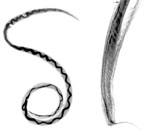Volume 24, Number 6—June 2018
Etymologia
Etymologia: Angiostrongylus
From the Greek angeion (“vessel”) + strongylos (“round”), Angiostrongylus (Figure) is a genus of parasitic nematodes (roundworms) in the family Angiostrongylidae, 2 species of which are known to parasitize humans. A. cantonensis (commonly known as rat lungworm) was first described in 1935 (as Pulmonema cantonensis) from rats in Canton, China. It is the most common cause of eosinophilic meningitis in Asia and the Pacific Basin, but cases have been reported in many parts of the world. A. costaricensis roundworms were first described in 1971 in Costa Rica from surgical specimens from children with eosinophilic infiltration in the abdominal cavity. The distribution of this species ranges from the southern United States to northern Argentina.
There is still debate about what taxonomic name should be used. A. cantonensis remains in general use, but some researchers suggest it should be changed to Parastrongylus cantonensis on the basis of the morphology of the adult male bursa and the definitive host being rats.
References
- Chen HT. A new pulmonary nematode, Pulmonema cantonensis, n.g., n.sp. in Canton rats [in French]. Ann Parasitol. 1935;13:312–7. DOIGoogle Scholar
- Cowie RH. Biology, systematics, life cycle, and distribution of Angiostrongylus cantonensis, the cause of rat lungworm disease. Hawaii J Med Public Health. 2013;72(Suppl 2):6–9.PubMedGoogle Scholar
- Morera P, Céspedes R. Angiostrongylus costaricensis n. sp. (Nematoda: Metastrongyloidea), a new lungworm occurring in man in Costa Rica. Rev Biol Trop. 1970;18:173–85.PubMedGoogle Scholar
- Simner PJ. Medical parasitology taxonomy update: January 2012 to December 2015. J Clin Microbiol. 2016;55:43–7. DOIPubMedGoogle Scholar
- Ubelaker JE. Systematics of species referred to the genus Angiostrongylus. J Parasitol. 1986;72:237–44. DOIPubMedGoogle Scholar
Figure
Cite This ArticleOriginal Publication Date: May 07, 2018
Related Links
Table of Contents – Volume 24, Number 6—June 2018
| EID Search Options |
|---|
|
|
|
|
|
|

Please use the form below to submit correspondence to the authors or contact them at the following address:
Ronnie Henry, Centers for Disease Control and Prevention, 1600 Clifton Rd NE, Mailstop E03, Atlanta, GA 30329-4027, USA
Top